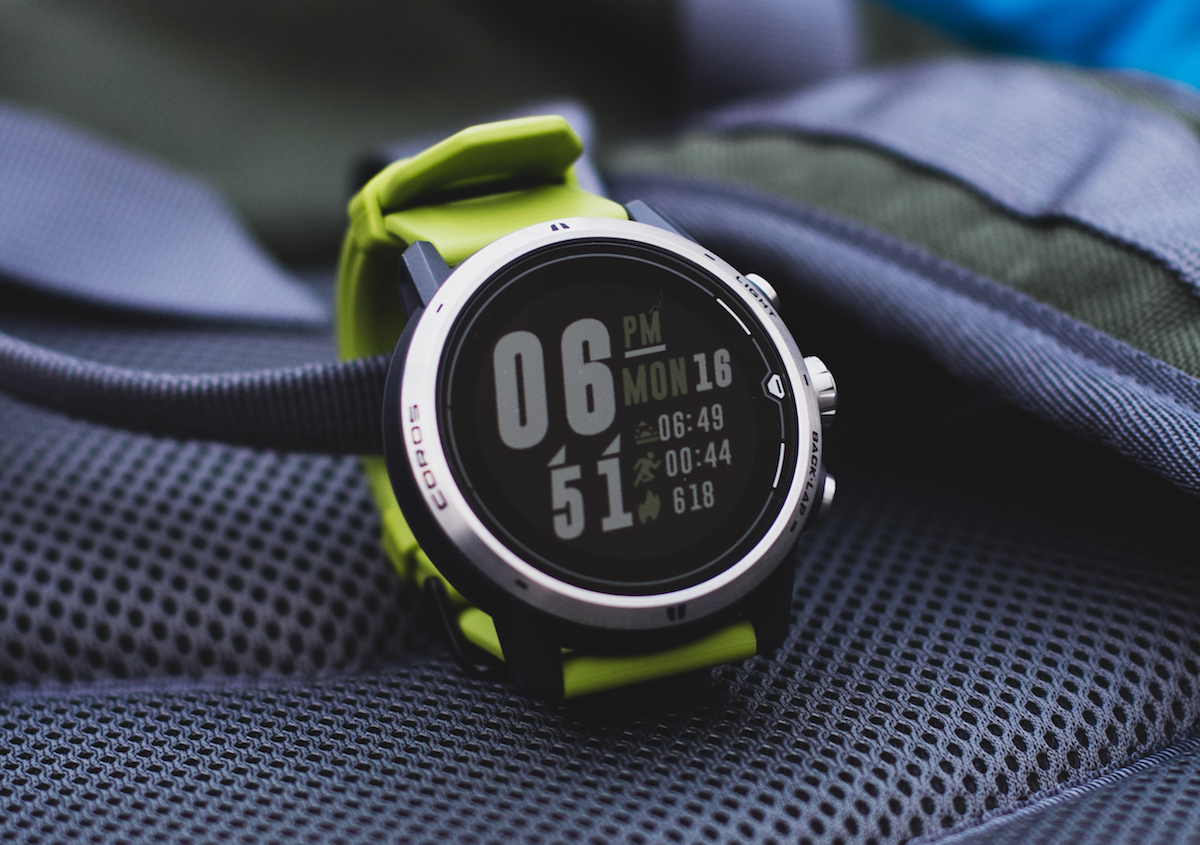
Welp, here we are. With the arrival of the COROS APEX Pro Premium Multisport Watch, the COROS family is now complete.
First came the Pace (which we haven’t reviewed). Then the APEX, who let the other GPS families in the neighborhood know that COROS was here and ready to shake things up. Shortly thereafter came the VERTIX, the wild mountaineer who could go into the wilderness for days without dying.
And here we have the APEX Pro, the sibling who gets straight A’s but still knows how to party and looks good doing so. It’s the kid that everyone wants to hang out with, and rightly so.
What it all boils down to is this—the APEX Pro is the most versatile piece in the COROS universe, combining all the best parts of the APEX and the VERTIX into one head-turning package.
Read below to find out why.
While the full spec sheet can be found on the COROS APEX Pro product page, here is a general rundown of the physical characteristics:
| Display Size | 1.2 in. 240 x 240 (64 colors) |
| Display Type | Touch Screen Memory LCD |
| Quick Release Silicone Band | 22mm |
| Physical Size | 47 x 47 x 13.4 mm |
And here’s another rundown of its specs vs. competitors (and the original APEX).

I thought the original APEX had a pretty nice design, but this one knocks it out of the park. I’m not gonna lie, I’d pay the extra $150 just for the looks.
The titanium alloy bezel is as clean-looking as a Naval officer on graduation day, and the sapphire glass is pretty much non-scratchable. To me, the size is just right without being too much. Over 47 mm and you start getting into bulky territory. Same with the 13.4 mm height. I really think this is the sweet spot of the COROS line as far as size.
At 59 g, the weight is on the heavier side of watches, but again, I didn’t find it to be noticeable.
The silicone strap is perfectly comfortable and comes in a variety of nice colors.
There are only three buttons, which is all I want or need: light, back/lap, and a push crown dial button.
Do not overlook the crown dial knob, which is oversized on the APEX Pro (the regular APEX has a smaller version). I cannot tell you how much I love this component. It’s so easy to scroll through menus and workout screens with one simple roll of the finger, even with gloves on.
At this point, I’m ruined for other watches from an ease-of-use perspective. I now hate using watches with stiff or sensitive buttons or too many button options that I can’t ever remember which button does what.
As with all of COROS’s watches, the menus are incredibly intuitive. COROS doesn’t supply any manuals for its products, which I found to be annoying at first. The truth is, you really don’t need them. Everything is somehow where you want it to be, as if you designed it. The settings, the activities, the app— all of it is so simple to use.
With the most recent firmware update, the COROS APEX Pro and the VERTIX both now have touch screens. But pump the brakes— it’s not like an Apple Watch screen. Instead, only certain screens are “touchable.” Users can swipe through activity screens, move left and right on daily timelines, or move the map when in navigation mode. But that’s about it.
Personally, I find the touch screen cool, but unnecessary. I actually never use it, because honestly, the crown dial is better at moving through things. I could see how it’s somewhat useful in navigation mode, but overall it’s pretty limited.
Oftentimes, I run commute (sometimes to more than one place) and I hate ending my activity. Or, if I pause it, it sits on the pause screen and I can’t actually use my watch to tell time or see any notifications that come through. Plus, it’s still pinging in full GPS mode the whole time, draining my battery.
This is all solved!
For any activity that is broken up (multi-stage races, bike-packing trips, grocery shopping, etc.), you can now pause your activity, exit your activity, and come back later to resume it. Once you enter the ‘Resume Later’ mode, it returns to the normal watch face and stops pinging GPS, saving your battery life and sanity.
This is something that needed to be done, and I’m so glad COROS did it. Granted, it is only currently available in Trail Running or Mountain Climbing mode, but hopefully this will extend to other activities soon.
The COROS APEX Pro now has 40 hours of battery life, 14% more than the APEX. See the Battery Life section below for more thoughts.
On previous versions of COROS watches, an activity pause went straight to a finish option and accidentally pressing the button again would wrap up your activity. Now, you have to hold down the button on finish for 3 seconds. A small, but needed, improvement.
Like the VERTIX, the APEX Pro now has an oximeter that allows for 24/7 blood oxygen monitoring with its Altitude Mode. I live pretty much at sea level, so had no way to test this, because you have to be over 8,200 feet to do so. Either way, this feature doesn’t mean much to me. But it’s on there.
Shop COROS APEX PRO
Not much has changed in the app since my original APEX review (which is why I’m using the same screen shots from before). It’s still a great app with intuitive features. Typical training options, including indoor options for everything.
For running, you simply press the knob, select run, and then have the option for typical run training, as well as aerobic, anaerobic, or interval training. I actually love that there are only four options for this because anything more is bloviated excess.
After your run/bike/swim, the screen provides a nice array of data that is easily scrolled through using the digital knob. Included in this set of data is your VO2 max, recovery advisor, threshold pace, last-7 days training load, and personal fitness index.
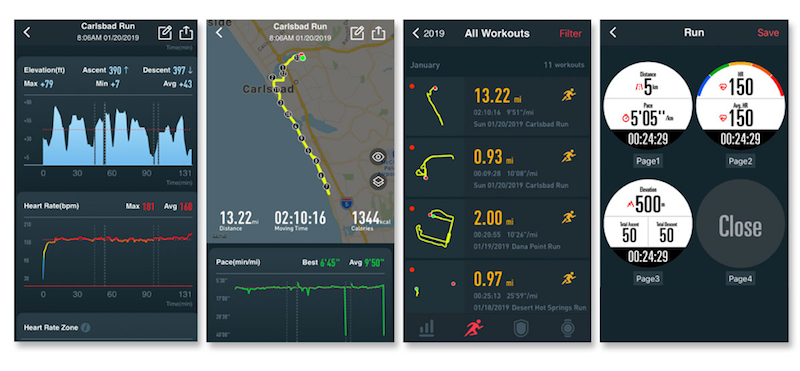
COROS is also able to determine your overall effort, broken down into stamina level (0-100) and training effect (0-6). Their built-in trainer will notify you that it’s time to rest up, and based on the effort level and training history, you will then be able to see an advised recovery window before you begin your next activity — additionally kind of cool.
When the original APEX came out last December, I was wowed by its battery life. At the time, 36 hours in full GPS mode was by far the best battery life in its class. Soon after, it was shattered by the VERTIX with its 60+ hours of battery life (though some sacrifices were made in the watch case thickness.)
Fast forward to now. The APEX Pro features 40 hours of battery life in full GPS mode, which will get pretty much any ultrarunner through a 100-miler, or an average marathoner through almost two weeks of training.
For general usage, it’ll last 30 days. In Ultra-Max GPS Mode you can score 100 hours, but probably no girls cause they’ll think you’re pretty weird.
I gotta say, the COROS battery claims are spot-on. For all the watches I’ve reviewed, the battery life specs never disappoint. During the APEX Pro testing, I wore the watch for about two weeks with about 50 miles of running before it died.
For most runners (I put myself in the category of “most runners”), I feel like 40 hours of full-GPS battery life is the perfect sweet spot. You’ll rarely have to charge it, and even on low battery you can probably get in a half marathon training run. It can also be accomplished without a hefty watch casing.
A full charge takes two hours, if you forget to charge it at some point, just plug it in as you’re getting ready for your run and you should be good by the time you’re out the door.
Shop COROS APEX PRO
One of the highlights of the original APEX was its quick connection to GPS satellites. Nothing has changed here; it typically connects within 15 seconds—from inside my house. Some voodoo GPS magic.
So I will say, I was a little concerned going into this review about accuracy. The VERTIX had some struggles early on (which seem to have been corrected with some firmware updates), and though the APEX was generally solid, it had some misses as well during early testing.
I’m happy to report that the APEX Pro returned excellent results in my two weeks of testing. Is it perfect? No, but I have yet to find a watch that is. In a city it may round off corners every now and then, but it never dropped or went severely off course. Overall, I was more than pleased with the results.
Below are some comparisons against a Garmin Forerunner 235 and a Polar Vantage V Titan, all set to GPS + Glonass with auto pause off (Galileo/Beidou is coming in future firmware updates). For testing purposes, the APEX Pro was on my left wrist, Forerunner on my right, and Polar V Titan in my SpiBelt.
Location: East Baltimore
Distance: 7.5 miles
Devices used: COROS APEX Pro (purple), Polar Vantage V Titan (red), Garmin Forerunner 235 (blue)
The below map was a 7.5 mile run through east Baltimore. The APEX Pro and Polar V Titan both came in at identical distances at the end, while the Forerunner registered only 6.90 miles. Odd. Especially since my run partner registered 7.5 on his Forerunner 945. My guess is that the Forerunner dropped in a parking garage that we ran through (as you can see below) and took a bit to recover.
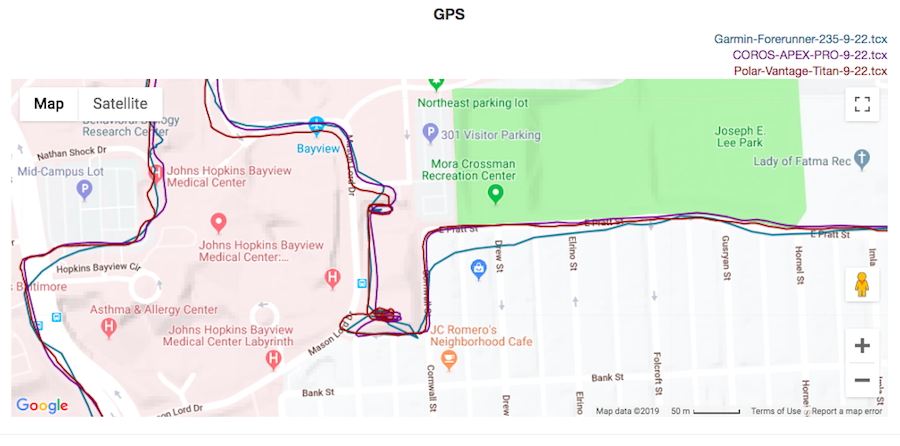
COROS APEX Pro (purple), Polar Vantage V Titan (red), Garmin Forerunner 235 (blue)
Here’s another spot on the run where the Forerunner severely cut a corner, while the APEX Pro and Vantage Titan both stayed on course.
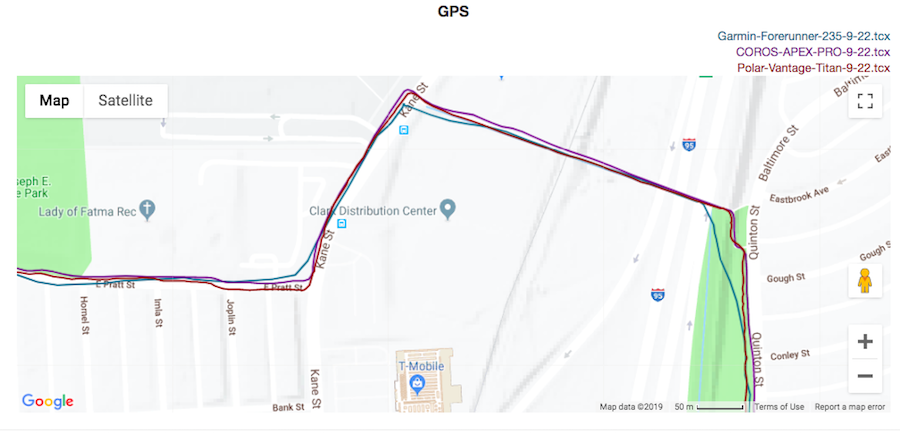
COROS APEX Pro (purple), Polar Vantage V Titan (red), Garmin Forerunner 235 (blue)
Location: East Baltimore
Distance: 8.5 miles
Devices used: COROS APEX Pro (purple), Polar Vantage V Titan (red), Garmin Forerunner 235 (blue)
On this run, I ran to the Baltimore Cemetery, which is a mostly open and unshaded route. It was actually an awful run, as it was like 92 degrees at dead noon (you can see where I stopped in the shade at the cemetery entrance). On this map, the Forerunner deviates a bit, but recovers and keeps a dead perfect line (no pun intended) in the cemetery.
Overall, this was a pretty good run for all watches involved. No severe drops or deviations that I felt I should note. All of them registered within .05 miles of the final 8.5-mile distance.

COROS APEX Pro (purple), Polar Vantage V Titan (red), Garmin Forerunner 235 (blue)
Location: Amelia Island, Florida
Distance: 5.5 miles
Devices used: COROS APEX Pro (purple), COROS VERTIX (red), Garmin Forerunner 235 (blue)
The growth on Florida trails is thick as hell, so while in the middle of it, I have no idea which watch performed the best. There was also an infestation of cute rabbits (seriously I probably crossed 50 rabbits in my path), but that has nothing to do with a GPS review. I also passed a spot in the wetlands that must have had a hundred cranes and spoonbills congregating only twenty feet away from me. Washed in the morning light, it was a beautiful place to run.
Anyway, you can see that while the COROS lines are pretty fluid, the Forerunner is somewhat geometric and goes pretty far off course when coming out of the woods, before correcting itself in the open wetlands.
Nevertheless, at the end of this run, the APEX Pro and Forerunner were identical, while the VERTIX was .15 miles under.

COROS APEX Pro (purple), COROS VERTIX (red), Garmin Forerunner 235 (blue)
Here’s the thing about watch-based Heart Rate Monitors (HRM)— they’re never really accurate. You can get a general reading, which is good enough for most people. But if you’re doing heart rate training or just want really accurate data, you need to have a chest strap monitor.
Like most watches these days, the APEX Pro has Bluetooth and ANT+ capabilities, so it can hook up to pretty much any external device. (I recommend Polar, because that’s what they’re best at.)
However, for this review, I’m strictly using the APEX Pro HRM vs. competitors. And yes, I use DC Rainmaker’s analyzer tool to chart my comparisons. He did a great job with it, and I don’t mind paying someone for a good product.
What I found is that the COROS APEX Pro is accurate enough to get a general idea of your heart rate, especially over the course of a workout, but shouldn’t be used as an accurate metric in real time. See below for more details.
Devices: COROS APEX Pro (purple), Garmin Forerunner 235 (blue), Polar H10 Chest Strap (red, connected to Polar Vantage V Titan)
In this first run, you can see that the APEX Pro is slower than both the Forerunner and the Polar H10 in the beginning, but once it catches up, it’s fairly consistent throughout, save for a few misses. I was actually somewhat shocked at how well the Forerunner performed in this example.

COROS APEX Pro (purple), Garmin Forerunner 235 (blue), Polar H10 Chest Strap (red, connected to Polar Vantage V Titan)
Devices: COROS APEX Pro (purple), Garmin Forerunner 235 (blue), Polar H10 Chest Strap (red, connected to Polar Vantage V Titan)
So this was a really weird one. This also correlates to the above example where the Forerunner was over a half mile short on the workout. As you can see, the Forerunner was a complete disaster. It had my average HR at 180 and max HR at 204, which I think would kill me.
Meanwhile, the APEX Pro performed admirably in comparison with the Polar H10. It lagged a little bit but was generally consistent throughout.
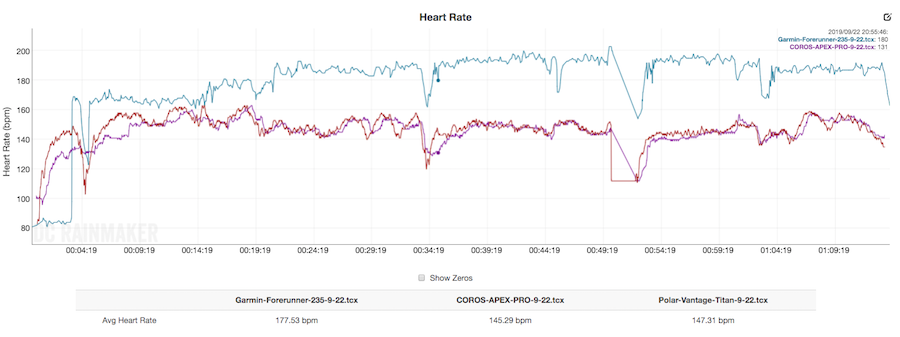
COROS APEX Pro (purple), Garmin Forerunner 235 (blue), Polar H10 Chest Strap (red, connected to Polar Vantage V Titan)
Devices: COROS APEX Pro (red), Garmin Forerunner 235 (blue), Polar OH1 Optical Heart Rate Sensor Armband (purple, connected to COROS VERTIX)
In this example, the COROS APEX is definitely a bit lagging and has a couple hiccups. On the other hand, the Forerunner is back to its normal self and stays pretty consistent with the Polar OH1 armband sensor.
My HR diving down in the beginning is accurate; I had just done a warmup then took about 20 seconds to turn on all five devices I was using for this run.
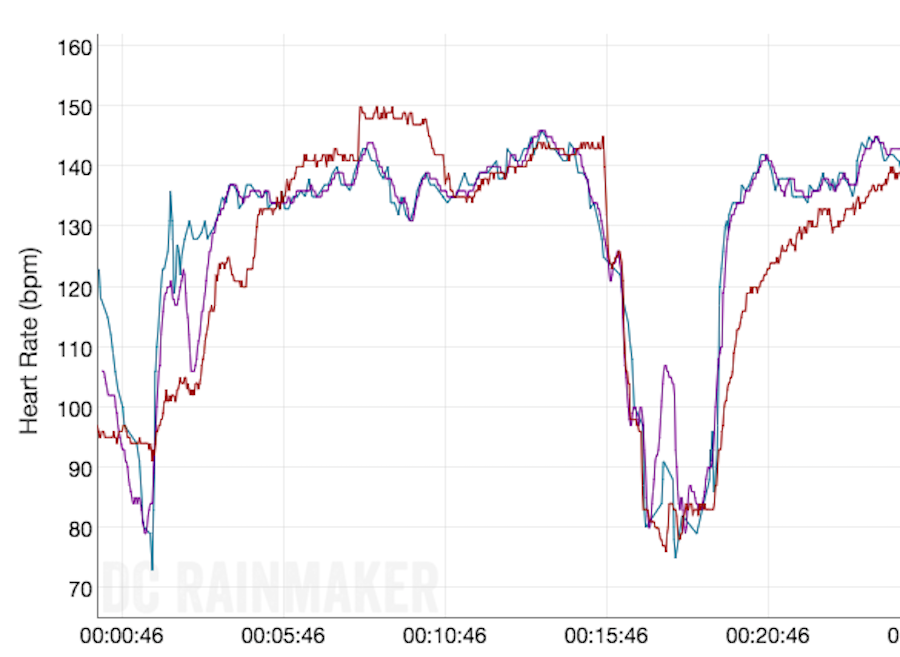
COROS APEX Pro (red), Garmin Forerunner 235 (blue), Polar OH1 Optical Heart Rate Sensor Armband (purple, connected to COROS VERTIX)
Currently, the COROS APEX Pro can sync directly to Strava, TrainingPeaks, RQ, WeRun, and the Health Kit on your iPhone. Let me say that syncing with all COROS products is freakishly fast. Like, from watch to phone to Strava in under ten seconds, and that’s a long run upload.
Look, I’ll never find myself close to 100 meters underwater unless I fall over the railing of a Carnival Cruise ship, pina colada still in-hand. In which case my last thoughts aren’t going to be “man, this is a cool watch.” They’ll be “man, I didn’t get to finish this pina colada.”
But I did wear it swimming in a pool and in the ocean for a few days last week and it still works. So that’s my extent of water testing.
One caveat: be careful in chorine pools. The black silicone band for my VERTIX had a chalky discoloration after a couple hours on vacation this summer.
The COROS APEX Pro isn’t cheap at $499.99. I get that it’s right in the middle of the APEX and VERTIX, but I’d like to see it maybe around the $450 range. I know that in the past COROS has had some trade-in incentives for current COROS owners, but I’m not sure if that still exists.
I gave the original APEX a pretty glowing review, and I still think it’s the best choice out there for the $300 range. Case in point: a friend of mine who routinely runs 70+ miles a week just tried out my APEX after using a Forerunner 235 for years. Long story short— he’s moving to COROS.
But if you have a little extra cash, and if you love a watch that looks good while not doing running things— this is the one for you. The sleek design and bonus features make this an all-around great choice that you won’t regret. Like I already said, I love the knob, I love the battery life, I love the multi-day feature, and I love the quick syncing and GPS locating.
The crown dial knob on the original APEX was really sensitive and was one of my main complaints in that review. This has been fixed. The knob is just the right amount of sensitive, which is what my mom used to tell me when the kids used to be beat me up for crying during the Pledge of Allegiance.
I also like the navigation option, which the early version of the APEX didn’t have (it does now). Garmin has had this for some time, so it’s good that it’s on here. If you like a route and download a GPX file from Strava (or ask someone to give you their file), it’s pretty easy to just upload to the app then onto the watch.
Shop COROS APEX PRO
Like all other COROS watches, the display can be somewhat dim. Now, simply pressing a button or turning your wrist will turn on the backlight, but I’d still like to see it improved. According to COROS, it’s not even to save battery life, it’s simply the coating on the screen that makes it darker.
For some absolutely annoying reason, COROS has yet to provide an option to delete an activity from the watch. This drives me insane. Reason being, because the sync to Strava is so stupid fast, you’re now that annoying person clogging everyone’s Strava feed with things like “one block walk to the bar.”
The training options on the APEX Pro are pretty scant. Because it doesn’t have a web interface, you can’t set up detailed workouts or training plans, then transfer them to the watch. The best it offers is timed intervals over a pre-determined distance with a warm-up and cool-down option.

I’m not surprised that COROS waited to release this watch last. It’s the best one of the bunch. When the original APEX was released last year I was already intrigued with COROS’s play into the GPS watch market. They clearly saw a path in through the bourgeoning trail scene and have since taken a firm hold on it. I mean, ultrarunners love this COROS shit.
Over that time, I have seen the fierce loyalty of Garmin customers, some who will defend the company to its death. To be honest, I think it’s more that nobody wants to admit they may have dropped $500 on a product that isn’t the best out there—whether that’s true or not.
So while COROS has made some moves, there is still work to be done. But they are absolutely on the right path. To be honest, it’s actually a little shocking that a startup company is producing quality goods at this level. I know they’re backed by a Chinese GPS company that manufactures a car GPS, but to have the quality of engineering and production this early on with only a few hiccups— it’s pretty surprising.
All that to say, COROS is definitely a company to “watch,” and the APEX Pro is a watch to seriously consider. You can purchase the APEX Pro for $499.99 using the shop link below.
Shop COROS APEX PROCOROS Global has partnered with Believe in the Run on promotional campaigns; however, all reviews are done independently of any sponsorship and are done in an honest effort to give our readers an unbiased opinion about shoes/gear.
Have something to say? Leave a Comment
Across the range, which of the watches can play music?
I know it’s totally not a fitness feature, but not carrying my phone is a big motivator in my _next_ watch purchase.
If offline music is important to you, then definitely go with the Garmin 245 music.
Great review. I really like the comparison against other models that are out on the market.
I have been a long time Garmin user and currently have the 935 but the time is coming that I look into finding a new watch.
I like what I’ve seen from Coros but not sure about making the switch due to user interface/software.
I am so comfortable with the Garmin software. I also like the fact that Garmin has a actual website, Garmin Connect.
Garmin has also just released the Fenix 6 and the specs are very impressive, battery life listed as 60 hours on GPS without using the music option.
Just wondering what your feelings are after using the Coros and do you think that Coros in a legitimate contender to Garmin and the other big GPS watch makers.
Thanks for your time and your thoughts.
I will say that I have not used the higher-end models of Garmin (I just don’t have that money!). And I would compare models like the Fenix 6 against the COROS Vertix, since they’re both meant for more adventurous pursuits.
If you enjoy a web interface, then it may be hard to switch over; however, I’ve never had a real need or attraction. If you also do super detailed workouts (e.g. pyramid workouts or progression intervals), then you should stick with Garmin.
I can tell you that the COROS interface and functionality are insanely easy and intuitive to use. There really is no need for a manual. I will tell you this- I actually let a friend borrow my COROS Apex while I tested the Garmin 235, and after a couple weeks of using it, he’s switching to COROS. So yes, they are a legitimate contender.
Great review on a pretty damn compelling piece. What kind of stress/recovery/body battery info does Coros provide? I can’t seem to find any detailed info out there. Thanks!
Honestly, that’s where COROS kinda comes up a bit short. They have some basic recovery stuff in the app, VO2 max, effort, etc., but it’s not crazy in-depth. Battery life is shown on the watch face, you just press the back button, and it cycles through where the step counter icon is. If you want crazy in-depth recovery/sleep/power metrics from a watch, I suggest Polar Vantage series (which we’ll be reviewing next week). Thanks for reading!